MOSFET Transistor: Basics, Working Principle, 2 Types & Uses
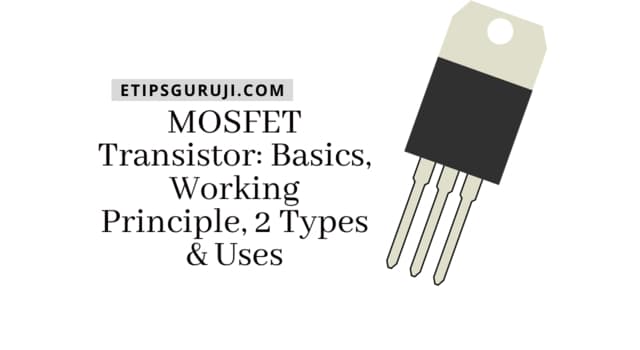
MOSFET Transistor is a special type of transistor that is used in various digital circuits and amplifying electronic signals. But if you ‘re in search of more application about the MOSFET transistor or want to gain more information about this post is for you.
In this post, we are going to discuss its types, application, advantages, and disadvantages, along with some frequently asked questions related to MOSFET transistor.
What is a MOSFET Transistor?
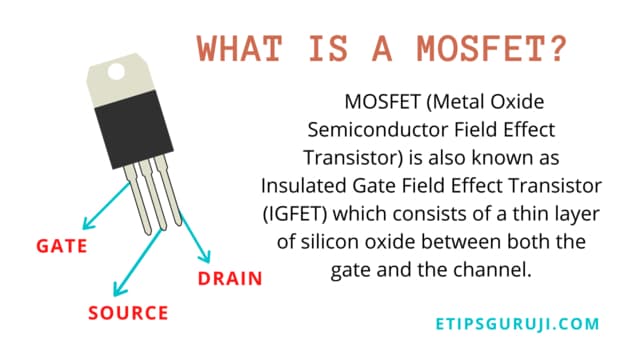
MOSFET (Metal Oxide Semiconductor Field Effect Transistor) is also known as Insulated Gate Field Effect Transistor (IGFET). MOSFET Transistor is nothing but a field-effect transistor, which consists of a thin layer of silicon oxide between both the gate (or drain) and the channel.
In general, it is a semiconductor device that is made with P-type or N-type doping. It is broadly used to change conductivity in electronic devices or can be used to amplify electrical signals.
Nowadays, MOSFET is more commonly used in both the analog and digital circuits. In short, we can call MOSFET the “workhorse” of the electronics industry.
People Also Read:
- How to Test Capacitors – Its Methods, Functions, and Types
- Digital Voltmeter- Principle, 4 Basic Types, Applications, Merits & Demerits
Construction of MOSFET Transistor
A MOSFET is specifically designed or constructed in such a way that it can easily be fabricated in a microprocessor because of its smaller size.
Additionally, they have four-terminal ports that consist of a gate, source, drain, and body. However, the body of the MOSFET transistor is not considered to be the port, so it makes it a three-terminal device.
MOSFET has the same structure as the Field Effect Transistor (FET). In general, a MOSFET has an oxide layer with which the gate is attached to the substrate. This layer of oxide acts as a conductor. And this is the reason why they are also called to be IGFET (Insulated Gate Field Effect Transistor).
While talking about the structure, the MOSFET transistor has a less doped substrate that is transmitted to a more doped region. Depending on the type of substrate used, we can call the MOSFET a P-type or an N-type MOSFET.
Characteristics of MOSFET Transistor
These are some of the characteristic features of MOSFET transistors.
Unipolar
Unipolar means single polarity. There are basically two types of polarities which are positive (hole) polarity or negative (electron) polarity. MOSFET is a type of field-effect transistor (FET) in which there is only one type of charge that is either electron or hole. That is why MOSFET is considered as unipolar.
Tri-terminal
MOSFET – A tri-terminal device consisting of source, gate, and drain.
Voltage Controlled Device
A field-effect transistor is controlled by the applied gate-source voltage. The gate voltage controls the flow of the input current that controls the electric field in a channel and this is why MOSFETs are considered to be voltage-controlled devices.
Working Principle of MOSFET
While talking about the main purpose of the MOSFET transistor, it is used to control the current flow between the source and drain. It acts as a switch and the working mechanism depends on the metal-oxide-semiconductor (MOS) capacitor.
MOS capacitor is an important part that helps the MOSFET to regulate the current. Semiconductor devices can be easily inverted by applying positive or negative gate voltages.
In a case where a positive gate voltage is applied, the holes under the oxide layer push the holes down from the substrate. This will finally attract electrons from the semiconductors source-drain channel region.
However, in a case, when the voltage is applied between the drain and the source of the semiconductor, the electric current flows freely. This sums up to the gate voltage channel that controls the electrons. Alternatively, if you use a negative voltage, a hole is formed under the oxide layer.
Types of MOSFET Transistor
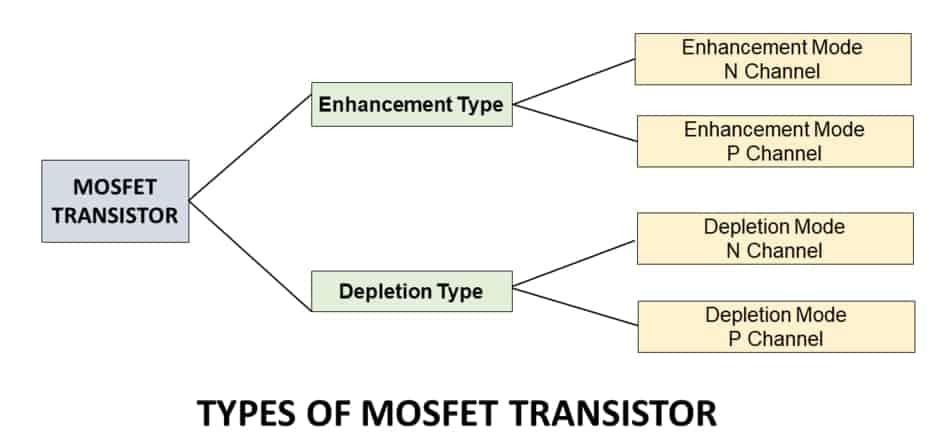
They are basically of two types of MOSFET transistors which are listed below:
- Enhancement Type
- Depletion Type
Enhancement Mode MOSFET Transistor
In Enhancement-mode MOSFET or eMOSFET, the conducting channels are doped to a level so that it becomes non-conductive. This results in a transistor that no conduction at zero voltage. Additionally, you can say that an eMOSFET is closed or “OFF” by default because of no existing channel.
So, as you increase the gate voltages more than the drain, the source charge carriers i.e. the holes shift away. And finally, they tend to leave the negative charge electrons which finally responsible for the wider channel establishment.
In short, the voltage of the gate is directly proportional to the current. This means as the voltage increases the flowing current also increases.
Types of Enhancement MOSFETs
The enhancement types can be classified into two sub-categories which are listed below:
- N Channel Enhancement Type MOSFETs
- P Channel Enhancement Type MOSFETs
N Channel Enhancement Mode MOSFETs
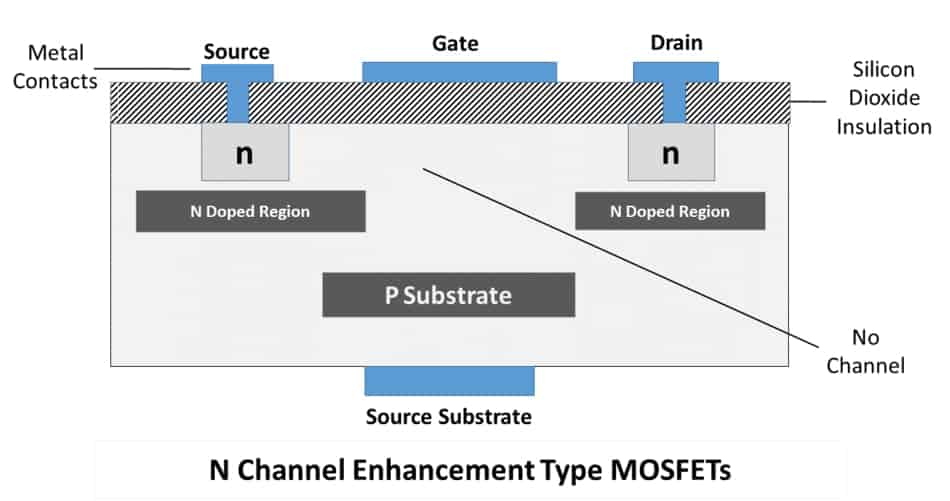
The body of an N channel eMOSFET is formed by a lightly doped P-type substrate, and the source and drain are heavily doped with N-type impurities.
These are some of the characteristic features of N channel eMOSFET:
- N-channel has majority-carriers of electrons.
- If the voltage applied to the gate is positive, then it turns the device “ON.”
- Due to the high mobility of electrons in an N channel eMOSFET, it tends to have a lower inherent capacitance.
- They have smaller junction areas that allow it to run at high switching speeds.
- It contains positively charged pollutants that prematurely turn “ON” the N-channel MOSFETs.
- The most common difference between n-type and p-type eMOSFETs is the low drain resistance in comparison with P-type eMOSFETs.
P Channel Enhancement Type MOSFETs
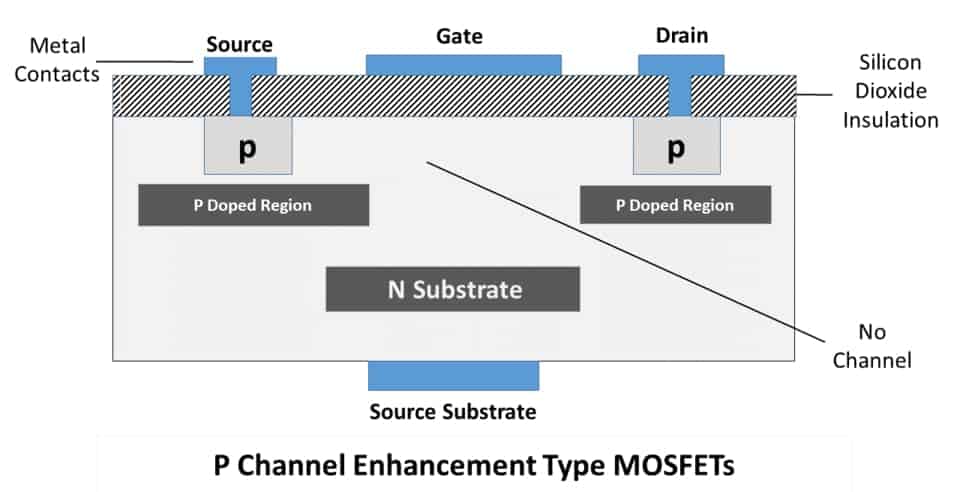
The body of a P-Channel eMOSFET is made by a lightly doped N-type substrate. While the source and drain are heavily doped with P-type impurities.
These are the following features of a P-Channel eMOSFET.
- P-channel has majority-carriers of holes.
- If the voltage applied to the gate is negative then it turns the device “ON.”
- Due to the low mobility of holes, it has a higher inherent capacitance which allows it to run at low switching speeds.
- Drain resistance in comparison with N-type is higher.
Depletion Mode MOSFET Transistor
This type of MOSFET is commonly referred to as ON device because when you connect a depletion type MOSFET, the current will flow from the drain to the source without any gate voltage.
A reduction mode MOSFET junction gate behaves similarly to a field-effect transistor (JFET). But when there is non zero voltage at the gate terminal, a depletion-mode MOSFET transistor channel shows the maximum current flow from the drain to the source.
As the gate voltage increases, the flow between the channels decreases. In short, in a Reduction Mode MOSFET, the gate voltage is inversely proportional to the current.
This means that as soon as the voltage at the gate is positive or negative charged, the conductivity of the channel decreases, and that’s the reason why they are used to power off the device.
Types of Depletion MOSFETs
In general, there are two basic types od depletion MOSFETs which are listed below:
- N Channel Depletion Type MOSFET
- P Channel Depletion Type MOSFET
N Channel Depletion Type MOSFET

In an N Channel Depletion Type MOSFET transistor, the semiconductor part is formed by the N-type substrate. While the source and the drain are heavily doped with P-type impurities.
Moreover, the voltage applied to the gate is positive which makes the channel depleted due to its free holes.
P Channel Depletion Type MOSFET
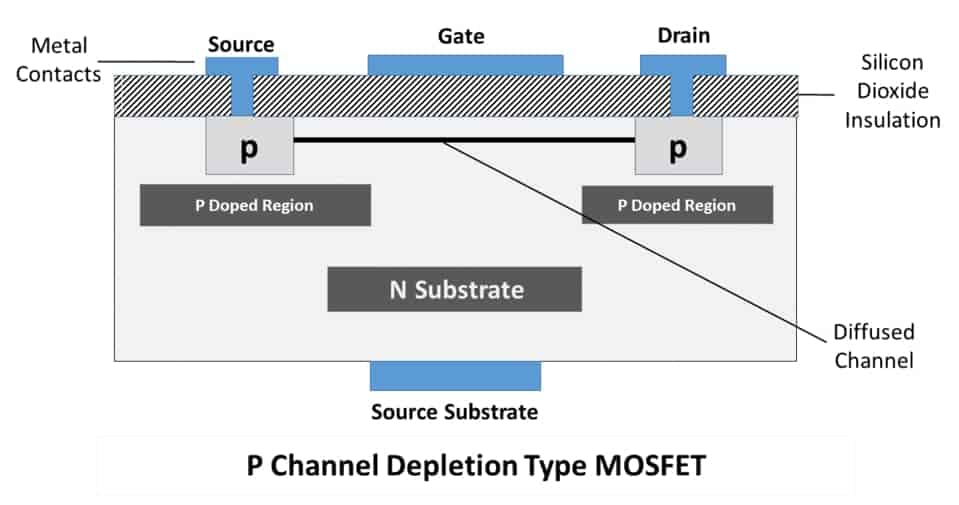
In a P Channel Depletion Type MOSFET, the semiconductor part is formed from the implication of p-type substrate on the other hand the source and the drain are heavily doped with N-type impurities.
In this MOSFET transistors, the voltage applied to the gate is negative and the channel of the MOSFET is composed of a majority of holes due to deflection in free electrons.
Symbols of Different Types of MOSFET Transistor
The following symbols diagram represents different types of MOSFET transistors.

Application of MOSFET Transistor
Here are some important applications of MOSFET transistor:
- MOSFET’s main function is used in digital circuits.
- They are helpful in switching and amplifying electronic signals in various electronic devices.
- It can be used as a passive element such as a resistor, inductor, and capacitor used in a circuit.
- Moreover, the other major application of MOSFET is as an inverter for electronic circuits.
- Additionally, they are also used in switched-mode power supply (SMPS) and as a high-frequency amplifier.
- MOSFET amplifiers are widely used in applications on radio frequencies.
- A brushless DC electric motor can be regulated by power MOSFET.
- They are also employed in electronic DC relays and also in voltage regulatory circuits.
- It is used in designing chopper circuits because of the high switching speed of MOSFET
Advantages of MOSFET Transistor
These are the following advantages of MOSFET Transistor:
- MOSFETs generally have a higher speed of operation and higher efficiency at the lower voltage.
- They have a very high input impedance.
- MOSFET has both enhancement and depletion operational modes which make it more acceptable in various electronic circuits.
- They are highly thermally stable and this is why they can act as a good resistor.
- They have less noise as compared to BJT.
- They operate at lower power and draw no current.
- A MOSFET can be used with switching terminals that means they have interchangeable terminals.
- Easy to manufacture and widely used as compared to JFET.
Disadvantages of MOSFET Transistor
The following are the disadvantages of MOSFET Transistor:
- The thin oxide layer can cause permanent damage to MOSFETs when removed by electrostatic charges.
- MOSFET has a short life because overload voltages make it unstable.
- It has a low output resistance.
- It requires special handling.
- Repeated calibration required for the exact measurement of the electrical values.
People Also Read:
- CMOS Battery- Full Form, Functions, and Replacement
- Types of Transformer (Categories Wise) – Working and their Applications
Difference Between MOSFET and BJT Transistors
These are various points that can help you to understand the basic differences between MOSFET and BJT. But we are going to discuss some major difference between the MOSFET transistor and the BJT transistor.
General Definition
MOSFET means Metal Oxide Semiconductor Field Effect Transistors which is a unipolar device. While BJT is abbreviated as Bipolar Junction Transistor and it is a bipolar device.
Terminal
A MOSFET has a tri terminal device that consists of a gate, drain, and body. On the other hand, BJT also a tri-terminal device but it consists of a base, emitter, and collector.
Working
The function of a MOSFET depends on the electrical field produced by a gate voltage which alters the charge carriers through the drain-source channel. While the function of a Bipolar Junction Transistor (BJT) depends on the current at the base terminal.
Controlled Equipment
MOSFET is a voltage-controlled device and is employed for high power functional applications. On the other hand, a BJT is a current controlled device but they are preferably used in low current applications.
General FAQ
What is a PNP transistor?
Ans. A PNP (Positive Negative and Positive) transistors have two p-type layers that are sandwiched with a third thin n-type layer. It is a current-controlled device that controls both the emitter and collector current.
Is MOSFET Transistor bipolar?
Ans. No, MOSFET is not bipolar but a unipolar. This is because the charge carriers are of the same type i.e. they are either to be holes or electron.
What does a MOSFET do in a 3d printer?
Ans. As we all know, MOSFET is a form of transistor that is used to control the power supply. So, MOSFET in a 3D printer helps to make the equipment less overheated.
Which is better: BJT or MOSFET?
Ans. It depends upon the application. In some cases, BJT is better than MOSFET because of its less capacitance values, so, for smaller applications usually less than 10V and around 1A, a small BJT could be a good choice. But for high power applications, MOSFET is far far better than BJT.
What are the causes of MOSFET to fail?
Ans. There are various reasons for MOSFET to fail but common cause of MOSFET failures are short-circulated load, dv/dt rate failure, faulty battery, extra power dissipation, current, blocked motor, and rapid acceleration/deceleration.
How did I know MOSFET is good or bad?
Ans. You can easily measure whether the MOSFET is good or bad, by measuring gate-source leakage with an ohmmeter.
